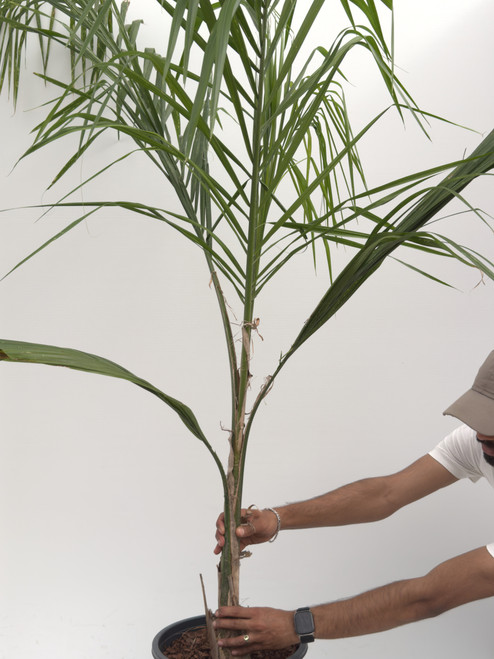Product Description
Habitat and Distribution
Brazil Northeast. Chapada Diamantina. In rock crevices on montane savannah, at elevations from 400 - 1,400 metres altitude.
Description
A small, clustering species with an acaulescant trunk, and small, regularly pinnate, bright green leaves with stiff, leathery leaflets, up to 2 metres tall. Occasionally having just a single, un-branched stem, the plant more commonly produces a small clump of subterranean stems, each of which is topped by a rosette of 3 - 8 leaves up to 1.8 metres long. Editing by edric.
Culture
From the tropics, it can also be grown in subtropical areas and might also succeed in warm temperate areas. The plant is probably tolerant of at least light frosts. Grows best in a sunny position, prefers a well drained soil, established plants are probably drought tolerant.
Comments and Curiosities
Uses: The waxy leaves are used locally as a kindling for lighting fires. The plant is occasionally cultivated as an ornamental.
The stemless palm Syagrus harleyi is endemic to the Chapada Diamantina, and the ecology and biology of the species remain unknown. The aim of this paper is to present the results of an analysis of the demographics of S. harleyi in six populations in the Serra do Sincorá, Bahia State, Brazil. We sampled 30 plots of 5 × 5 m. The height and the number of leaves per rosette (ramet identifiable above ground) were recorded. We also recorded the presence of reproductive structures, the length of the sheaths and if the rosettes occur alone or in clumps. It was found 787 rosettes, with 0.98 rosette per m2. No significant differences were detected between populations. The Kolmogorov-Smirnov test found no significant differences in the expected distribution of frequencies of height classes. Most populations had a predominance of intermediate height intervals, but two had a predominantly basal distribution. There were significant differences between sterile and fertile rosettes regarding their height and number of leaves, as well as in number of sheets present in clumps compared to isolated rosettes. The clumps had, on average, 3.91 ± 3.78 rosettes, but two clumps showed 15 and 28 rosettes. The density was found higher than that reported in other works. Studies with other stemless palms also identified the prevalence of intermediate height intervals, a fact credited to episodic recruitment events. However, the vertical growth of the leaves in the early stages of its development can influence plant height. The results indicate that S harleyi may develop as a single rosette or branched individuals forming clumps, which determines four patterns of growth. Comparison with other studies shows that it is difficult to establish on to genetic patterns in stemless palms, perhaps due to the initial development of these plants, which may occur in the underground. (Demography of Syagrus harleyi, a stemless palm endemic to the Chapada Diamantina, Bahia State, Brazil. (Cezar Neubert Gonçalves, Felipe Weber Mesquita, Fernanda Andrade Viana)
A clustering dwarf species from the mountains of eastern Brazil from 400 to 1400 m (1300 to 4600 ft.). The Fox Palm produces an underground trunk and small, regularly pinnate, bright green leaves with stiff, leathery leaflets. It grows well in warm temperate and subtropical climates and can be used, for instance, in a rock garden, as an unusual ground cover, or as a bonsai potted palm. (RPS.com)









